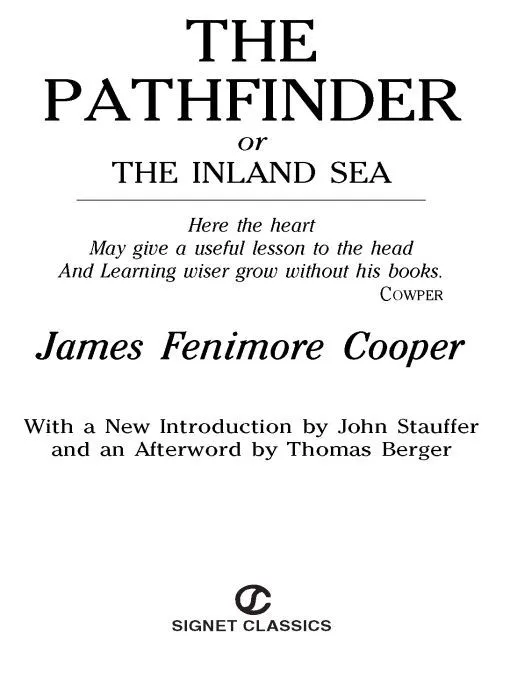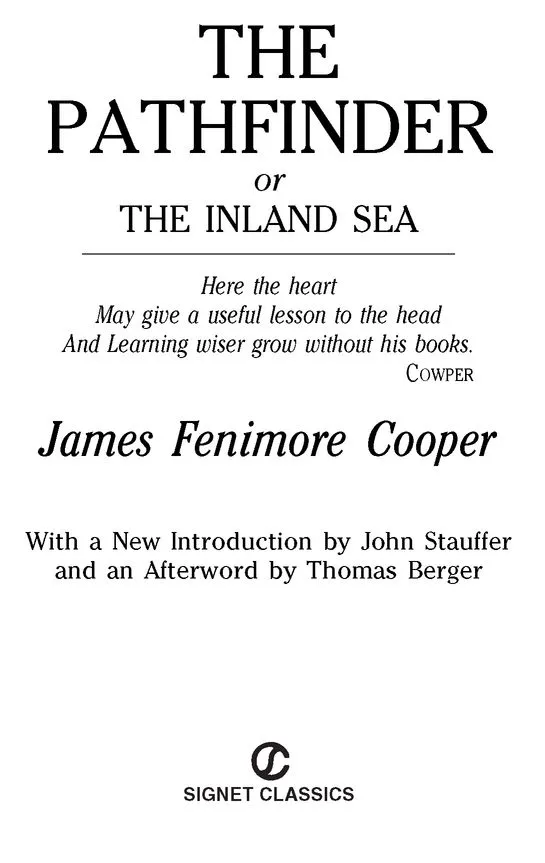The Pathfinder

Table of Contents
Title Page
Copyright Page
Introduction
PREFACE
CHAPTER I
CHAPTER II
CHAPTER III
CHAPTER IV
CHAPTER V
CHAPTER VI
CHAPTER VII
CHAPTER VIII
CHAPTER IX
CHAPTER X
CHAPTER XI
CHAPTER XII
CHAPTER XIII
CHAPTER XIV
CHAPTER XV
CHAPTER XVI
CHAPTER XVII
CHAPTER XVIII
CHAPTER XIX
CHAPTER XX
CHAPTER XXI
CHAPTER XXII
CHAPTER XXIII
CHAPTER XXIV
CHAPTER XXV
CHAPTER XXVI
CHAPTER XXVII
CHAPTER XXVIII
CHAPTER XXIX
CHAPTER XXX
AFTERWORD
SUGGESTIONS FOR FURTHER READING
A NOTE ON THE TEXT
James Fenimore Cooper (1789-1851) attended Yale College but was expelled. Sailing before the mast, he saw Europe for the first time on a merchant vessel. In 1808 he became a midshipman in the U.S. Navy but resigned in 1811 and married. From 1826 to 1833, he traveled extensively in Europe. With his story The Pilot (1823), Cooper set the style for a new genre of sea fiction. The Leather-Stocking Tales were published from 1823 to 1841. Arranged according to the chronology of their hero, Natty Bumppo, who appears under various names in all five romances, the sequence is The Deerslayer, The Last of the Mohicans, The Pathfinder, The Pioneers, and The Prairie. A caustic critic of his young country, he wrote The American Democrat (1838) as a critique of his society at the time.
John Stauffer is Professor of English, African and African American Studies, and the History of American Civilization at Harvard University. He is the author of the award-winning The Black Hearts of Men: Radical Abolitionists and the Transformation of Race (2002) and numerous essays in such publications as Time, Raritan, and 21st: The Journal of Contemporary Photography. He is at work on a new book, Imagining Equality: American Interracial Friendships in History and Myth.
Thomas Berger was born in 1924 in Ohio. He worked as a librarian and a journalist before his first novel, Crazy in Berlin, was published in 1958. Other novels include Little Big Man (1964), Neighbors (1980), The Feud (1984), Best Friends (2003), and Adventures of the Artificial Woman (2004).

SIGNET CLASSICS
Published by New American Library, a division of
Penguin Group (USA) Inc., 375 Hudson Street,
New York, New York 10014, USA
Penguin Group (Canada), 90 Eglinton Avenue East, Suite 700, Toronto,
Ontario M4P 2Y3, Canada (a division of Pearson Penguin Canada Inc.)
Penguin Books Ltd., 80 Strand, London WC2R 0RL, England
Penguin Ireland, 25 St. Stephen’s Green, Dublin 2,
Ireland (a division of Penguin Books Ltd.)
Penguin Group (Australia), 250 Camberwell Road, Camberwell, Victoria 3124,
Australia (a division of Pearson Australia Group Pty. Ltd.)
Penguin Books India Pvt. Ltd., 11 Community Centre, Panchsheel Park,
New Delhi - 110 017, India
Penguin Group (NZ), cnr Airborne and Rosedale Roads, Albany,
Auckland 1310, New Zealand (a division of Pearson New Zealand Ltd.)
Penguin Books (South Africa) (Pty.) Ltd., 24 Sturdee Avenue,
Rosebank, Johannesburg 2196, South Africa
Penguin Books Ltd., Registered Offices:
80 Strand, London WC2R 0RL, England
First published by Signet Classics, an imprint of New American Library,
a division of Penguin Group (USA) Inc.
First Signet Classics Printing, January 1961
First Signet Classics Printing (Stauffer Introduction), July 2006
eISBN : 978-1-101-11920-4
Introduction copyright © John Stauffer, 2006 Afterword copyright © New American Library, a division of Penguin Group (USA) Inc., 1961 All rights reserved
 REGISTERED TRADEMARK—MARCA REGISTRADA
REGISTERED TRADEMARK—MARCA REGISTRADA
The scanning, uploading, and distribution of this book via the Internet or via any other means without the permission of the publisher is illegal and punishable by law. Please purchase only authorized electronic editions, and do not participate in or encourage electronic piracy of copyrighted materials. Your support of the author’s rights is appreciated.
http://us.penguingroup.com
INTRODUCTION
“I AM A TRUE HISTORIAN,” James Fenimore Cooper stated, “a describer of society as it exists, and of men as they are.” His fiction was read as “people’s history”—narratives that explained America and its past to the masses. He was one of the most popular writers in Europe and the United States from 1820 to 1850; and most Americans understood their new nation partly through his fiction. Cooper’s Leatherstocking Tales, so named because the central hero, Natty Bumppo, dressed in skins and lived in the wilderness with his Indian friends, were among the most popular books in antebellum America and remained popular throughout the twentieth century. These five novels—The Pioneers (1823), The Last of the Mohicans (1826), The Prairie (1827), The Pathfinder (1840), and The Deerslayer (1841)—describe the birth of America from the era of King George’s War in 1740 to the first white settlements in the Louisiana Purchase territory in 1804.
Most Americans treated the Leatherstocking Tales as history. The historian Francis Parkman borrowed heavily from The Last of the Mohicans to write his epic history of the Seven Years War. He called Natty Bumppo “the epitome of American history” and confessed that Cooper’s protagonist “seem[ed] so palpable and real” that he sometimes “confounded” Natty’s experiences with “the memories of [Parkman’s] own experiences.” The Ojibwe leader George Copway declared Cooper’s Indians to be accurate portrayals of actual Indians: “No living writer, nor historian, has done so much justice to the noble traits of our people,” he wrote in 1851. And the French novelist Honoré de Balzac, in a glowing review of The Pathfinder, called Cooper “the American novelist, or rather let me say the American historian.” Cooper’s “high place” in literature, Balzac said, stemmed from his ability to accurately portray “the sea and seamen” and “the magnificent landscapes of America.” Throughout the Leatherstocking Tales, Cooper emphasized that his narratives were based on fact and true to the spirit of his nation’s past.
Cooper was obsessed with American history. He was born in 1789, the year the Constitution was ratified, and died in 1851, as the country was splitting apart over the slavery controversy. He witnessed the gradual end of slavery in the North; its spread into the South and West; the Indian Removal Acts of the 1820s and 1830s; the rise of a white man’s republic; and the hardening of racial hierarchies. He sought to make sense of these vast changes by voraciously reading and writing. From 1820 to 1850, he published thirty-five novels and eighteen volumes of nonfiction—almost two books a year for thirty years. His writing explored “the rules of coexistence” between diverse groups of people “that make human society possible,” as the critic Jane Tompkins noted. To that end, he created the largest body of interracial literature of any nineteenth-century author: Indians or blacks are main characters in fourteen of Cooper’s novels and minor characters elsewhere.
Indian-white friendships constitute the core of the Leatherstocking Tales. With them Cooper helped create a national literature by drawing extensively on the nation’s past and pairing a white hunter with his Indian companion in a setting that was wholly different from Europe.
1 comment